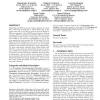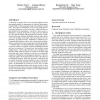59 search results - page 6 / 12 » Google's MapReduce programming model - Revisited |
CLOUDCOM
2010
Springer
13 years 5 months ago
2010
Springer
Many scientific applications suffer from the lack of a unified approach to support the management and efficient processing of large-scale data. The Twister MapReduce Framework, whi...
SIGMOD
2007
ACM
14 years 7 months ago
2007
ACM
Map-Reduce is a programming model that enables easy development of scalable parallel applications to process vast amounts of data on large clusters of commodity machines. Through ...
CCS
2008
ACM
13 years 9 months ago
2008
ACM
Single-Sign-On (SSO) protocols enable companies to establish a federated environment in which clients sign in the system once and yet are able to access to services offered by dif...
SIGMOD
2010
ACM
14 years 10 days ago
2010
ACM
As the study of graphs, such as web and social graphs, becomes increasingly popular, the requirements of efficiency and programming flexibility of large graph processing tasks c...
POPL
1989
ACM
13 years 11 months ago
1989
ACM
raction that a programming language provides influences the structure and algorithmic complexity of the resulting programs: just imagine creating an artificial intelligence engine ...


